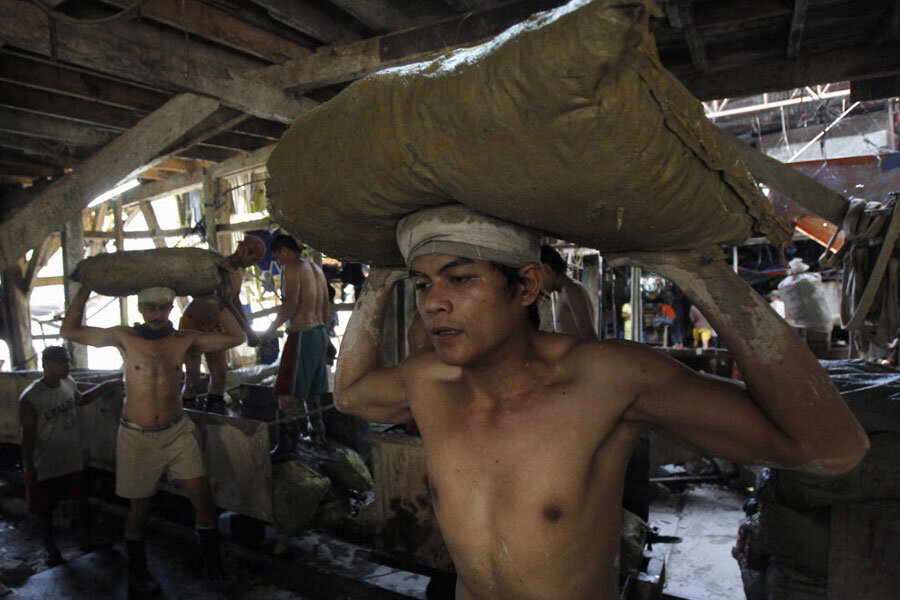End of Eden? Mining push in Philippines ends isolation of islanders
Loading...
| Puerto Galera, Philippines
A path cut through a forest hillside outside this resort town is no ordinary road. It will soon connect the modern world to an indigenous tribal group that until now has lived mostly in pre-modern isolation.
Does this road represent the end of a lifestyle and of farming and food sources that villagers have relied on for millennia?
Ask Gabayno Uybad. He grew up in a typical indigenous Mangyan village on Mindoro Island, far from the developed coastline. The community, where people farm both for themselves and the collective, lies seven miles from a modern highway.
Mr. Uybad, a Roman Catholic priest, shares the concern of many tribals here that the road could enable large-scale commercial mining on an island that is rich in copper, iron, and nickel. Recent studies have shown significant ore deposits, and just last year a major mining project got approved here.
Roads for miners would end the prized seclusion of many Mangyan people who populate a network of isolated villages and farms here in the center of the island – and take away the soil and water they need to survive.
“The activities are quite strange for us,” says Uybad, a Mangyan who has a master’s degree from a college near Manila. “In open-pit mining, they strike the whole mountain and in some cases the water might be polluted. We care for the environment and produce food, not necessarily for money, but for our consumption.”
Mindoro is divided into two provinces. Some 14 years ago the government of Oriental Mindoro banned large-scale mining; the other province, called Occidental, has not taken a position.
Yet it is the central government in Manila that has authority to issue crucial mining permits.
More mining permits issued
President Benigno Aquino’s administration has stepped up the issuing of mining permits, seeing a path to economic development in a nation where one quarter of the population lives below the poverty line.
Now tribal advocates here fret that after Mr. Aquino steps down in May his successor as president could be even more aggressive.
Last year an alliance of Philippine indigenous peoples called Katribu launched a Facebook page for the Mangyan cause, saying tens of thousands will be displaced. In 2011 some 500 Mangyans protested the research of sites by three foreign firms. Yet what clout the tribals can actually muster in Manila is unclear.
“The national government has moved to invite or attract foreign investors,” Mr. Uybad says. “We the Mangyan are asking the government to protect our lands. But the government is very slow.”
Among the current candidates running for president of the Philippines, “none have strongly opposed mining,” says Jonathan Ravelas, chief market strategist with Banco de Oro UniBank in Manila. Mining firms “look forward to a new administration,” he says.
The Philippines is the world’s fifth richest mineral nation, with reserves of about 14.5 billion metric tons. IHS, a market research firm, has identified five major iron reserves on Mindoro: three areas with copper, and two with nickel deposits.
In the past, mining projects in the Philippines have been held up by environmental opposition and squabbles over how to divide proceeds. Analysts say that permits on Mindoro would likely be issued piecemeal rather than as a flood.
Authorities on Mindoro did not respond to requests for comment on mining permits. Officials in Manila referred only to a set of older policy documents.
If change is to come, it is likely to start in Occidental Mindoro, the province without a ban. Yet the biggest new mining permit, for nickel, and granted last year to a Norwegian-invested company, was rammed through by Manila.
Norwegian-invested Intex Resources says it’s in the “development phase” of its project, which was first proposed in the 1990s. It was initially resisted since its proposed 44 square miles of operation would take place near drinking water supplies. Now it has an environmental compliance certificate from Manila.
Intex says it will respect the tribes. “The indigenous tribes which will be affected are treated as stakeholders and as such, their legal and social rights are respected through the observance of all the requirements under law,” company President Joselito Bacani says.
Likely to break up indigenous culture
Development will bring change. Some of the island’s 100,000 to 200,000 Mangyan people have never seen Philippine modernization and the development on the coast. Many males still use loincloths as clothing. Some Mangyan people prefer that isolation.
“They’re not so organized on the Occidental side, so mining companies can use that vulnerability,” said Edwin Gariguez, a fellow priest who lived with the Mangyan people from 1993 to 2010. The US-based Goldman Environmental Foundation gave him an award in 2012 for resisting a proposed nickel mine.
Mining is likely to would break up the Mangyan culture, Mr. Gariguez says.
“They will be displaced because when mining projects come they will excavate,” he says. “Mangyan people say ‘the land is life for us.’ They’re really unlike others, who can apply for employment at various companies.”
At a Mangyan village in Puerto Galera, a few dozen families in stilt-raised bamboo houses tend chickens and scratch a living from selling handicrafts to a trickle of travelers. Some don't speak the dominant Philippine language Tagalog.
“Generally Mangyans are very subdued,” says a resort operator near Puerto Galera. “They usually will go with the flow. If there is mining, they will adjust to it."







